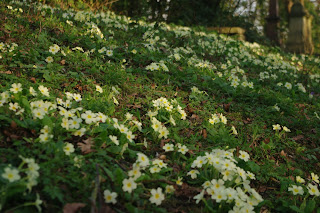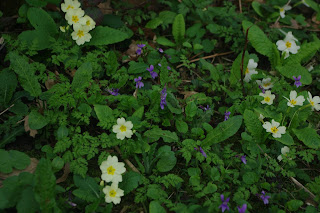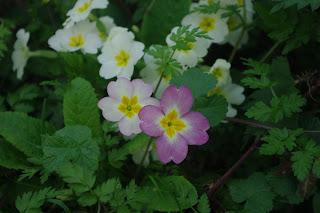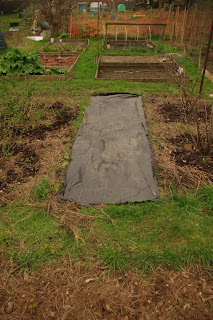A diary of back garden botany, urban ecology, rural rambles and field trips to the middle of nowhere...
Sunday, 31 March 2019
I planted some Wild Tulips (Tulipa sylvestris) on the allotment last autumn. They're not edible but I wanted to see how they do in a sunny spot. Despite being named sylvestris they seem to do better in the open and haven't really prospered in the garden which is shadier.
They grow wild in southern Europe and a few locales in Britain but the assumption is that they were bought to these shores from the continent. These seem to be doing well though the species has the reputation of being rather sporadic in flowering. It was grey earlier today when I took the photograph above but when the sun shines the flowers open wide:
Saturday, 30 March 2019
Narcissus Thalia is an "heirloom" daffodil- an old cultivar of the species N. triandus which grows wild in France, Spain and Portugal. I planted quite a few in the grass and borders a few years ago and it's been a treat to gaze upon them over a coffee every morning this week before heading to work.
To my mind it's the most graceful of all the daffodils- it's almost impossible for white flowers to look out of place in any garden. Each stem bears two or three flowers:
Friday, 29 March 2019
This bank of Primroses (Primula vulgaris) is going strong in Nunhead Cemetery at the moment.
On closer inspection I noticed the Primroses were growing among a carpet of Dog Violets (Viola riviniana).
Mostly, the Common Primrose flowers in variable hues of yellow.
But these pinkish-magenta flowers sometimes appear. I had always assumed this form to be a cultivar of garden origin but one of the gardeners at the South London Botanical Institute told me recently that they are a naturally occurring variation.
That seems to be borne out by these two Primroses growing in close proximity. One has flowers very pale yellow, almost porcelain in tone. The other has a flower with the merest blush of pink and also a flower that is stained a shade pinker but not the solid pink/magenta seen in the previous photograph.
Wednesday, 27 March 2019
Symphytum Hidcote has flowers of a blueish or pinkish tinge in early spring, and as I mentioned a week or two back bees love all Comfreys. This one makes good ground cover; it's semi-evergreen here in London and very hardy.
I chose the photo above partly for the bumblebee on the flowers and also for the bee hovering slightly to the left- a Hairy Footed Flower Bee (they always appear in the garden at this time of year). NB click on the photo to enlarge for a better view.
The male of the species devotes a great deal of energy to seeing off other bees by hovering ever closer then ramming them off the flower! This doesn't seem to do any harm to the bee that gets rammed which generally carries on foraging until it gets fed up of being repeatedly headbutted and buzzes off.
There's something comical about the determination of Hairyfoot to guard his territory. I remember watching one getting more and more agitated at the presence of an enormous bumblebee doing the rounds. It was like watching a pocket battleship square up to a dreadnought. Eventually even Hairyfoot thought better of this unequal contest and gave up.
Tuesday, 26 March 2019
Alpines haven't really figured in my dreams and schemes for the garden. But I was in a garden centre where they had a tray full of Arabis alpina subsp. caucasia, sometimes called Mountain Rock Cress. Very pretty and mobbed by bees. At £1.99 each it seemed silly not to buy one and a bee actually followed me towards the checkout trying to pollinate the one I had in my hand!
Sure enough as soon as I had potted it up and hung the pot on a nail on a sunny wall it attracted the attention of a passing pollinator:
I suppose I never really saw the appeal of growing alpines until recently, a rockery is not really my thing. Then last year I hiked high up on Mount Eddy in California beyond the lush mountain meadows into the seemingly arid elevations above. And it was teeming with alpines; far from the confines of suburbia these are the plants of vast open landscapes...
Monday, 25 March 2019
And speaking of the allotment (see previous entry) I also created a new bed between the fruit bushes. Last year I laid down some landscaping fabric to suppress the rampant couch grass.
Even Charles Dowding the guru of no-dig advocates removing couch grass before commencing a no-dig system. I did indeed dig the strip over and pulled out some pretty healthy couch roots despite being covered for quite some time.
I didn't want to crowd the fruit bushes by planting anything too substantial; the thought occurred to me that it would perfect for a bed of strawberries. I already had a number of strawberry plants here and there on the allotment so I lifted and consolidated them in the new bed.
These are several varieties I bought last spring and I've forgotten what they are! I created a couple of mini paths across the bed with strips of willow edging laid flat- a purchase from my local poundstore because thrifty gardening is good gardening...
Sunday, 24 March 2019
Planting a Crimson and Gold Quince (Chaenomeles x superba) was one of several tasks that took me to the allotment. My father mentioned a while back it would be nice to have a flowering quince and I saw a particularly vigorous one in Martin Crawford's forest garden recently which I learned was the Crimson and Gold cultivar:
NB Chaenomeles are shrubs and different from the Quince Tree (Cydonia oblonga) though related. The fruits need to be cooked and are said to make very tasty jams and jellies.
The flowering quinces are of Eastern origins but seem to be completely hardy in the UK. They must be tough. The one shown below is growing within the privet hedge in front of the house where I grew up and was there when my parents moved in:
Actually Chaenomeles can be used as a hedging plant but I will let the one on the allotment grow as a standalone shrub to harvest the fruit in due course.
Saturday, 23 March 2019
Wednesday, 20 March 2019
Planting bulbs "in the green" in springtime is the preferred option to establish certain bulbs that don't like to dry out, like Snowdrops or in this case Ramsons. They're available for sale in the autumn but unless freshly lifted they're likely to be dead in the packet rather than dormant.
I was contemplating ordering some Ramsons aka Wild Garlic (Allium ursinum) to plant in a shady spot under the apple tree. Then I remembered that I'd planted six or seven in a container several years ago, going spare from a planting I did by the back door. They've come up every year in the container so I reckoned they would do fine- and in fact they've multiplied to about twenty!
They were easy enough to separate by carefully tipping out the container as one block of earth then teasing out the individual bulbs and their roots from the loose soil. I suppose in effect I had done on a small scale what bulb producers do in bulk. I kept five back and potted them to grow some more "stock"- a deliberate strategy this time rather than a happy accident.
Postscript Today is the Vernal Equinox, the astronomical start of spring/end of winter!
Tuesday, 19 March 2019
Each "globule" on a Grape Hyacinth's spike is a flower. They bloom from the bottom first then upwards to the top which is true of most spikes of flowers. This one looks to have reached about the halfway point. Bees stick their tongues into the urn shaped vessel of the flower; a patch of Muscari armeniacum soon catches their attention.
Monday, 18 March 2019
Bees love all Comfreys. White Comfrey (Symphytum orientale) is one of several varieties in the garden. Here in London it has been in leaf all winter and is already flowering, whereas out of town I notice clumps of it are just starting to become bushy and form the flower buds.
By growing three or four different Comfreys it's possible to have one or another in flower from early spring to mid-summer. The leaves are rather similar but the flowers range from pure white to sky blue, from creamy white to lemon yellow, not to mention shades of pink, red, purple and magenta. Some are creepers, some are clumpers, all are vigorous and apt to spread (which I approve of). It's said that cultivars like Bocking are sterile so not invasive but Comfreys interbreed very happily and off they go.
We have the bees to thank for that and the bees will favour any garden with Comfrey in it.
Sunday, 17 March 2019
Reinstated a small pond on the allotment. Apparently the original pond was scrapped by the previous tenant when he stepped in it! So having cleared the debris and excavated the hole a bit I put a new liner down and part filled it with water from a nearby trough, the rain can do the rest.
I particularly want to encourage frogs to spawn. Frogs don't eat fruit and veg but they are partial to slugs and snails.
Saturday, 16 March 2019
Rhizomes for dinner! Stachys affinis (Chinese Artichoke) spreads by rhizomes i.e. underground stems that put out roots and shoots. The tubers are a thickened part of a rhizome that swells to store nutrients. The potato is another such plant. Like the potato S. affinis has edible tubers, though much smaller!
I have yet to try one but it is said they can be eaten raw or used in stir frys. Chinese Artichokes do indeed originate in China but they're not an artichoke being of the Lamiaceae (mint/deadnettle) family. The flowers resemble those of Stachys sylvatica (Hedge Woundwort) and Stachys officinalis (Betony), in fact the plant has sometimes been called Artichoke Betony. A further common name is Crosne, the area of France where they were grown as a vegetable in the late 1800s, possibly the first such cultivation in Europe.
I bought the pot shown above from Edulis, the specialist plant nursery that propagates many interesting and unusual edibles and plants in general. Indeed it started out as a grower of plants suitable for forest gardening and permaculture.
I saw that the "Crosnes" had already begun to multiply so I teased out some of the loose tubers and planted them with the main clump on the allotment. I noted the spot with a square of canes because there's nothing to see as yet.
NB to the left of the photo are some Leeks and towards the right above the square Allium ampeloprasum var babinigtonii is coming up. These are Babington's Leek aka the Wild Leek which is the ancestor of our cultivated Leek:
Friday, 15 March 2019
Grape Hyacinths (Muscari armenaicum) are not only ravishing- they're cheap as chips to buy by the bagful as autumn planted bulbs. They seem to do fine in any sunny or semi-sunny spot and require no attention once in the ground. They're not rare, who cares?
Besides the spikes of blue flowers in spring another thing I like about them is that they reverse the usual order where bulbs are concerned and come into leaf in autumn. Each bulb throws up a cluster of long narrow leaves which last through winter and for a while after flowering. I wouldn't grow them for their foliage alone -which is "grassy"- but I treat them as a kind of groundcover in places. I'd rather see some green than bare earth over the winter months. They're ideal for filling in spots in spring ahead of larger summer flowering perennials.
In a book I have somewhere there is a photograph of a whole hillside covered with them in the Taurus Mountains of Southern Turkey which would be a sight to behold. On a somewhat smaller scale the ones above are a cheery sight in my front garden.
Thursday, 14 March 2019
Still mulling over the Forest Gardening course I went on recently in conjunction with re-reading Martin Crawford's excellent book "Creating a Forest Garden". He notes that an "underplanted orchard" is a form of forest gardening i.e. a two-storey approach.
The UK has a long tradition of orchards and fruit trees so perhaps this could be particularly applicable here; a crossover between horticulture in the traditional sense and permaculture.
Monday, 11 March 2019
Hope springs eternal! Siberian Bugloss (Brunnera macrophylia) should do fine in the garden here. It's a tough plant that spreads happily in shady areas - in theory. I've tried it several spots and it didn't take to any of them. Then a friend gave me a clump last year and it seems to be doing well so when I saw these two in coir pots at my local garden centre I couldn't resist.
A few weeks from now I will post a photo of the lovely sky blue Forget-me-not flowers that B. macrophylia puts out in spring- I hope!
Saturday, 9 March 2019
Community gardens are part of the patchwork that makes up London's open spaces. I spent the day at the Forest Farm Peace Garden in Hainault with a crowd from London Permablitz who do good works across the city with an emphasis on applying the principles of Permaculture.
They run an interesting program of events, talks, workshops etc. at Cecil Sharp House in Camden but take the show on the road in a very practical way with the Permablitzes. Typically a group of 10-20 volunteers meet to "blitz" a bunch of tasks over the course of a single day to implement a particular design or project at that location. Tools and materials are provided (and delicious food!).
Today was the third such visit to Forest Farm to prepare and plant an area of edible plants which are native or long established in the UK. The project is funded by Kew Garden's "Grow Wild" initiative in the context of Forest Farm's work in providing therapeutic, community and educational resources.
Thursday, 7 March 2019
Abraham, Isaac and Jacob. When I arrived at the South London Botanical Institute today a discussion of Bible lore was in progress prompted by this pot of Trachystemon orientalis. It's sometimes called Oriental Borage (though it hails from the Balkans and Turkey and it isn't Borage). It's also known as Abraham, Isaac and Jacob hence talk of the Scriptures which didn't shed any light on how T. orientalis came to acquire that name.
Pulmonaria officinalis is probably my favourite flower of early spring so it was a pleasure to see it in numerous spots around the garden. P. officinalis has various common names, the most common being Lungwort. Another is... Abraham, Isaac and Jacob. In this case I believe it might be a reference to the flowers changing colour from red to pink to blue as they mature but common names are frequently obscure and elusive.
Primroses (Primula vulgaris) were gleaming in the sun all over the place. I have all of the above species at home but the Primroses are slow getting going for some reason and there are only a few Lungworts so it was good to get my fix at the SLBI.
The airy flowers of Cardamine quinquefolia were flourishing in several large patches. Another one I have in the garden which has yet to show itself! Plants have good and bad years according to the conditions (and perhaps last year's drought has left its mark?) so I hope C. quinquefolia hasn't gone for good.
I helped out with some mulching of the beds at the front of the building where several of these triffids are doing well. This is Echium pininana sometimes called Giant Bugloss or Tree Echium which isn't far wrong as it grows to be three or four metres tall with countless small blue flowers in summer.
It's a biennial (or sometimes triennial) that originates in the Canary Islands. Intriguingly it has been appearing in parts of the UK as a self-seeded wild thing (and each one must deposit thousands of seeds after flowering). I see it frequently in South London though less so north of the river. I have even seen it in Dorset villages. I assume it is naturalising in milder areas and becoming increasingly cold tolerant as a species i.e. the progeny that have greater resistance to cold will be more likely to survive and in turn pass this on as a genetic trait.
Some ecologists bemoan the spread of "alien" species but actually I like it when the aliens have landed. The arrival of this one must be good news for bees. Giant Bugloss is a decent enough common name for E. pininana but perhaps I'll start calling it Abraham, Isaac and Jacob- see if it catches on.
Wednesday, 6 March 2019
Dry shade is a tough spot to choose plants for; these are some of the ones that have worked for me. This Stinking Hellebore (Helebore foetidus) deserves a special mention- particularly since it's growing in an old ashcan! It's been flowering since Christmas and it's still going.
Trachystemon orientalis has a reputation for being invasive but it makes a good groundcover in shade. I have a patch in the driest, shadiest part of the garden where it does fine; perhaps the conditions keep it in check because it hasn't spread much. The leaves start small and get considerably larger- it has Borage-like early flowers which are mobbed by bees.
White Comfrey (Symphytum orientale) is very tolerant of dry shade and perhaps the most elegant of the Comfreys with its crinkly leaves and pure white flowers. Spring flowering, like most shade adapted plants (i.e. before the tree canopy leafs up). Another bee magnet.
Corydalis solida flowers prettily in early spring in part shade then dies back over summer as the tubers become dormant till next year. The tubers seem unaffected by the soil drying out during that time, in fact it seems to suit them. Various pink/lilac/purple/red forms are available.
Euphorbia amygdaloides var. robbiae is a stalwart of the dry shade garden. The ones I planted are steadily increasing and weaving through the fronds of Iris foetidissima, another robust plant for these conditions.
I. foetidissima is sometimes called the Stinking Iris but like the Stinking Hellebore it's nothing worse than a musty smell that's detectable if you crush the foliage. The small flowers in summer are pale and delicately veined but the berries are a bright orange splash that lasts throughout winter.
When I began to tend this garden nearly a decade ago it was particularly dry and shady towards the back, an interesting challenge. At the end stands a large sycamore. The garden next door on the north side had a mature evergreen oak and the garden on the south side a large cherry tree. The sycamore is still there but last year the oak was felled and the cherry tree -which was ailing- came down in high winds.
It will be interesting to see what effect this has on the existing plants and I'm intrigued to know what new ones might be able to flourish.
Tuesday, 5 March 2019
Wonderful weed: the Red Dead-nettle (Lamium purpureum). It appears all over the place at this time of year and keeps on flowering well into autumn. Lamium species are much frequented by bees so the long season of this one makes it an important source of nectar and pollen. It's a diminutive but prolific annual that thrives on disturbed ground be it in the town, city or countryside; the patch above is on the allotment.
Subscribe to:
Comments (Atom)

















































